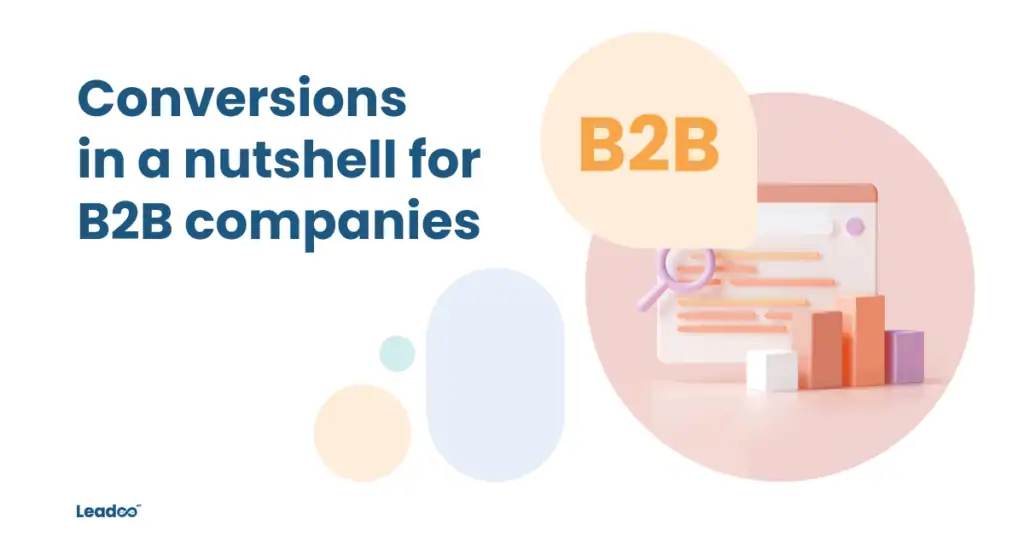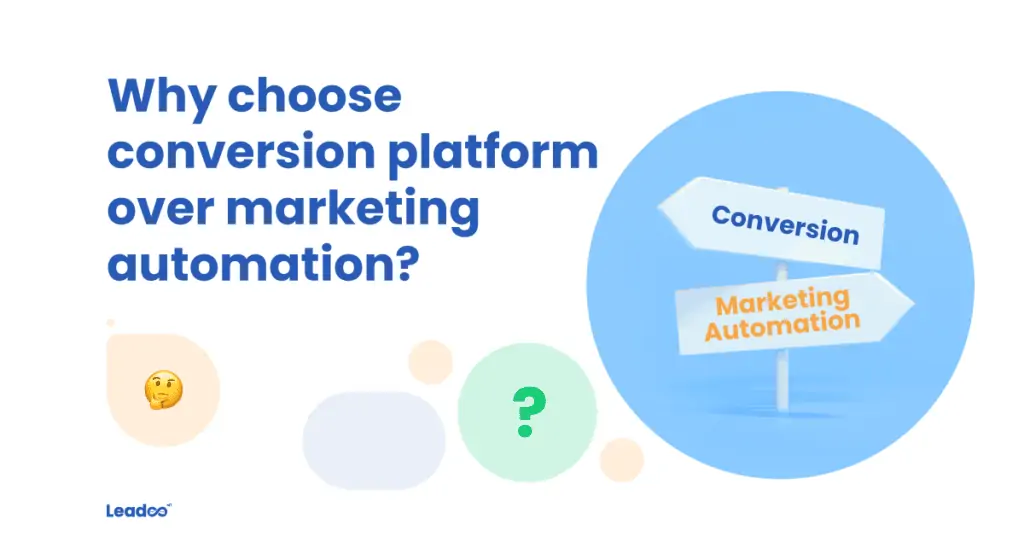We’ve been raving about conversions and we’re going to continue doing so. You know why? Because conversions are directly linked to your bottom line.
Conversion rate optimisation is often mistaken to be very technical, tricky, and time-consuming. But, it can be done in a very holistic way and eased into your existing processes.
With this article, I’m going to run you through 4 ways to optimise your conversion rates with a holistic approach.
Note also that I’m not going to preach our platform to be the be-all and end-all. If you want to know more about how Leadoo can help you, I’ve put bots across the article in relevant places, so you can click through if you feel like it. Conversions 💙 Consent.
Let’s kick this off with calculating conversion rate and then gracefully glide towards the four different ways to optimise your conversions, dear B2B marketer.
And as a reminder, conversion is an action a website visitor takes that’s important for your business. Demo requests, quote requests, newsletter signups etc.
How to calculate conversion rate
The formula is simple: conversions/visitors * 100.
But because we live in the 21st century, please use our handy conversion rate calculator and calculate yours 👇🏼
Conversion rate optimisation
4 ways of optimising conversions
Optimising website conversion points
This is an easy start.
First, make sure you have relevant conversion points on your website. It’s the most common pitfall to not have relevant conversion points in their rightful places.
Provide conversion points relevant for the whole customer journey, not just the end part.
If you currently have just a hard, end-of-the-funnel conversion point, try adding a couple more before that. Say, your conversion point is currently a quote request, try adding a “free consultation” or “free evaluation”, to gain the interest of the audience who is not quite there yet to ask for a quote, but interested enough to have a chat with you.
It’s also important to make sure that you have these scattered across the website, on the pages you are directing traffic and putting other efforts to.
So very often blog articles are missing an actual conversion point, even though someone has spent time and effort on creating the said post. Make all of your efforts work for you by having relevant conversion points across the website.
If you’re running paid campaigns and directing that traffic to a landing page, make sure the landing page is equipped with more than just one conversion point – and that the conversion points are connected with your campaign messaging. This allows you to connect with more people than having just one hard conversion point.
Optimising website content for conversions
This brings us to the next point – optimising the website content for conversions.
Let’s dissect this one to three main points:
- Optimising landing pages
- Optimising product / solutions pages
- Optimising conversion content (downloadables etc)
Optimising landing pages
Consider your landing page visitor’s journey. How did they end up on your landing page? From which channel did they come from? What messaging did they see that brought them there?
Follow these three steps:
- Tie in the ad messaging, landing page messaging and your key value prop within the first third of your landing page. Chances are your page visitor won’t check any further if this part of the landing page isn’t worth it for them.
- Make sure you have more than just one conversion point, being very mindful towards the audience who isn’t ready for a hard end-of-the-funnel conversion yet but would be ready to convert in some relevant way.
- Direct your landing page visitor towards some other valuable content after they’ve converted. This is a drastically under-utilised tactic, but a seriously powerful one. You already have their attention, so make the most of it.
Optimising product / solution pages
These tend to be tricky, since every company wants to present their own offering to be the best, the one, the “do it all”. This often reflects the offering pages’ content.
To create highly converting offering page content, there are three things to consider:
- Know your audience. Start with your current customers. Why did they buy from you? What do they see being the biggest value you provide? How do they understand your services?
- Create content for your audience, not for yourself. Make the content easy to skim through, so pay attention to headlines and bolded bits within the content.
- Add relevant conversion points, accounting for the different phases in your website visitor’s journey. And remember “Contact us” never piqued anyone’s interest. Ever.
Optimising conversion content
Here’s one word that should always be at the forefront of your mind: value.
All the content that gets created for purely converting purposes needs to be valuable for your audience. Never do this solely for the signups, for email addresses, for that explicit permission to be in touch. Do all this content to truly add value to your audience.
How to make sure that the content is truly of value? Talk to your audience and to your customers. Create a small group of people to whom you’ll send these and ask for their feedback.
Remember, conversations lead to conversions.
Optimising navigation
Website navigation is something that usually gets created, then forgotten, and then recreated during the next website redesign. This being said, quite often the navigation would benefit from small changes and tweaks along the way to serve its purpose the best – and serve your visitors, too.
How to build a navigation that allows your visitors to find what they’re looking for and convert with ease:
- Put your navigation to a place where your customers expect to find it. Don’t hide it because of a fancy design, your website visitors are not playing hide and seek on your website.
- Use vocabulary that is familiar to your audience.
- Make sure your navigation is optimised for all devices. Your visitors expect a top-notch experience on all the devices.
- Make sure your navigation has visual cues on what your visitor is scrolling through. It makes it easier for visitors to hop along on your site, when they understand where they’re at now and what’s more to browse.
- Don’t forget the footer – it has a lot of space and it’s a gold mine for B2B companies.
Optimising marketing and sales funnel
Sometimes optimising the funnels bring in the best results. I bet there is no need to argue how many things there could be to optimise and this might present a problem on what to choose to optimise in the marketing and sales funnel?
There is a simple process for this:
- Start with mapping the outlines for your marketing and sales funnel to fully understand what’s happening in each phase.
- Identify the biggest bottlenecks. I truly mean just the biggest bottlenecks that withhold the biggest potential.
- Choose a bottleneck that withholds great potential and has the quickest time-to-value when fixed.
Examples of such bottlenecks can be, for example, inadequate inbound lead processes or handling, lead scoring or nurturing lost cases, or the ones who fall into the “maybe later”-pipeline.
CRO for B2B in a nutshell
Like a true B2B marketer, I was able to put two acronyms in one headline.
But conversion rate optimisation for B2B companies in a nutshell would look like this:
- Choose the point that has the biggest impact on your business and quickest time-to-value
- Understand your current situation and set goals accordingly
- Document your optimisation process
- Rinse and repeat
And a few good reminders…
- You don’t need ten million tools and three PhDs to do CRO – you need customer understanding and access to the tools you have in use today
- You will fail, but that’s the game. When doing CRO, failing is very important, so don’t get bummed by this. You learned something!
- You’ll need discipline to continue with CRO. One-time-try doesn’t count as optimisation, it’s a one-time fix.
Now, just get cracking, you got this!


